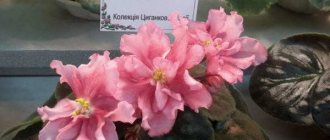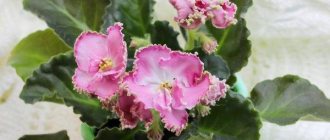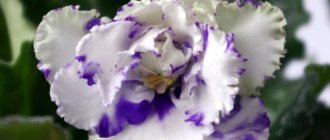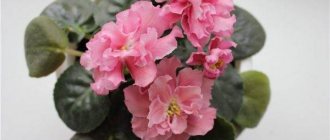A plant very similar to the violet growing in Europe, only more delicate, was discovered in the Usambar Mountains by the German governor Baron Saint-Paul in the 90s of the 19th century.
In Russia, Saintpaulia appeared at the beginning of the 20th century, at first only in the greenhouses of botanical gardens and very rarely from private individuals.
The first varieties of Uzambara violets bred in the USSR
began to appear in the 50s of the last century . One of the leading practitioners and theorists of Saintpaulia selection was the married couple Boris Mikhailovich and Tatyana Nikolaevna Makuni.
Violet, description and photo SM-Maysky Rosehip (seedling K. Morev)
Violets from breeders of the CIS countries - “M” (Morev).
SM- Maysky Rosehip (seedling K. Morev).
(Another name is Our Hope).
May Rose Hips, Maiskiy Shipovnic (K. Morev).
Large single and semi-double bright pink stars with a clear sparkling contrasting crimson edge.
Medium green oval-pointed quilted foliage. Standard. The rosette is good, but the petioles are a little long, it turns out a little loose and spreading. The variety tends to elongate leaf petioles.
Large bright pink flowers with a fuchsia edging of an original shape. The flower is shaped like a lotus flower. The shape of the flowers is very beautiful. The flowers are about 5 cm in size. There are 5-6 buds on the peduncle.
Abundant and bright bouquet flowering the first time. Blooms for a long time. During the second flowering it produced a huge cap. Peduncles are strong, but rather long. The plant is unpretentious and is not afraid of transplants. Very prolific, produces many babies.
Rosehip May (cinnamon). A low shrub 60-200 cm high with ascending branches covered, as a rule, with paired sickle-shaped spines. The flowers are large, pink, regular. The fruits are berry-shaped, containing nut-shaped achenes. Blooms in May-June. The fruits contain a very high concentration of ascorbic acid, vitamins B, PP, K, panthenolic acid, flavonoids, phenolic acids, pectic substances, organic acids, salts of iron, manganese, phosphorus, magnesium, calcium. In folk medicine, not only rose hips are widely used, but also flower petals and plant roots.
Do you know that…?
To protect your collection from possible infection by pests and diseases, you must: •— Do not place plants too tightly so that there is free air circulation to avoid the appearance of fungal diseases. •—Create and maintain optimal conditions for keeping plants: temperature 18-24 degrees, humidity 50-60%, daylight hours 8-12 hours, soil pH 6.0-6.8. •—Remove faded peduncles, shoots, old yellow deformed leaves, along with petioles, in a timely manner. Rotten leaves are also a source of fungal diseases. This will not only give the plant a healthy, beautiful appearance, but also promotes rapid flowering.
•— Never bring bouquets of garden and wild flowers home. Garden flowers and cut flowers in the house are taboo at any time of the year. In summer, be sure to cover open windows and vents with netting and tulle. •— Old pots, soil, containers, and tools cannot be used without treatment. •— Urgently isolate diseased specimens from other plants, try to find out the cause and begin treatment.
Before you buy the violets listed below, carefully read the forums about their behavior on the windowsill. Many of them are very beautiful flowers. However, these can be large rosettes with large and fragile leaves, with leaves rising up or hugging the pot, forming many stepsons that interfere with the formation of a neat rosette, pulling the stem up and growing into a Christmas tree, bending the trunk, rare flowering with long breaks, fallen flowers or they last little and quickly wither, very long and recumbent peduncles, the color of the flower fades quickly, they do not like bright lighting on the windowsill, they are afraid of the slightest drying out or waterlogging, a large percentage of them go into sports or darken the flower.
Are they suitable for your window sill and the conditions that you can create for them? You will look at the flowers for several months, and the rosette will always be in front of your eyes. There are many beautiful flowers, there are much fewer beautiful and neat rosettes, look first at the rosette! Search and you may find a dozen violets with the same flower color if you are not interested in the smallest details as a collector.
•— Mystical Mermaid (Morev);
Violet SM-Our Hope: description and cultivation of the variety
Saintpaulia is a beautiful herbaceous plant. East Africa is considered its homeland. Today Saintpaulia is the most popular indoor plant. Among amateur gardeners it is known as Uzambara violet. This article discusses the SM-Our Nadezhda variety, which has its fans among connoisseurs of indoor flowers.
Violets, domestic varieties
Violets, domestic varieties
—
Our Hope
| First flowers. Really very large. Flowering is 100% varietal! | Portrait | First Bouquet |
| Second bloom | Very bright flowers. With a good border, large, clear star-shaped. | Mature plant. |
Page 1]
Photo albums
- Violets, foreign varieties
- Violets, domestic varieties
- Varieties of Korshunova
- Lebetskaya varieties
- Repkina varieties
- Mini, semi-mini
- Trailer violets
- Chimeras
- Episces
- In the interior, or how we grow
- Daughter's orchids
- Winners and prize-winners of photo exhibitions
© 2011-2016, “Violets in Altai”
Personal website of Tamara Bobina,
Site Map
e-mail:
Website development "Active Design"
Peculiarities
The description of the variety says that this violet is distinguished by large star flowers with a rich crimson outline, which can be simple or semi-double. The shape of the flower resembles a lotus. The foliage is medium green. Flowering is quite strong, in clusters.
For a culture to grow and develop well, it needs good lighting at least 10 hours a day. If the flower is located on the windowsill of a window into which the sun rarely peers, then provide additional lighting using phytolamps.
Violet SM-Our hope does not like drafts and cold. Because of this, when ventilating, it must be removed from the windowsill. The optimal temperature for it in the summer season is +25°C, and in the winter – at least +18°C. You cannot keep a flower near a cold window in winter, because this causes hypothermia of the roots.
Violet loves moist air. The higher the humidity levels, the better for the plant. In summer, containers with Saintpaulia are placed in a container with wet sphagnum or expanded clay. In winter, when the heating is on, it is also necessary to ensure a high level of humidity around the pot with the crop. It is not advisable to spray violets, as the liquid leaves stains on the leaves, making the appearance of the crop unattractive. Air irrigation is carried out at a distance of about 2 meters from the flower.
"Balchug flight"
A magnificent, stable chimera with a small, even rosette. Propagated by stepsons of a rosette or from a trunk. As a rule, there are a lot of them. The flower grows quickly and begins to bloom early. Blooms profusely and often. When they first bloom, the flowers are usually simple, and then they become semi-double. For such a miniature rosette, the flowers are quite large. Peduncles are erect and strong. Each of them contains from 3 to 7 flowers, which last a very long time, forming a luxurious bouquet that covers the rosette.
This violet is completely unpretentious in care. The description of the variety and reviews from the owners allow us to recommend it even to novice collectors. For abundant and long-lasting flowering, good lighting is necessary - up to twelve hours a day.
Planting and replanting
For Saintpaulia SM-Our Hope, you can prepare the substrate yourself, although ready-made options are also offered at retail outlets. Violet likes loose soil. To prepare the substrate, take the following elements in proportions of 3: 5: 1:
The soil should be well breathable and absorb moisture.
This will contribute to better development of the root system. They plant violets in a container that is not very spacious, because it blooms only in a cramped pot. Before planting a flower, holes are punched in the bottom of the container so that all excess moisture drains into the tray and the root system does not rot. In addition, drainage must be provided.
Saintpaulia is replanted once every 36 months. But if the plant is young, then it should be replanted every 12 months. In this case, the substrate must be changed. The procedure is carried out in the spring season.
The initial stage of fertilizing is spring, when intensive flower growth is observed. The second time, fertilizing is applied after Saintpaulia has completely faded. Fertilize the plant once every half month. In winter, fertilization should be stopped.
Violet has special requirements for watering, which will change in accordance with maintenance standards. This depends on the humidity and temperature in the room. It is necessary to water with settled water at room temperature when the soil dries out. In winter, watering should be carried out three times every 7 days, and in summer - every day or every two days. Moisture should not be allowed to stagnate: this will lead to rotting of the underground part of the plant. You should use a watering can with a narrow spout so that the water passes the leaves and the center of the flower, otherwise it will slow down the growth point.
Some use another method of saturating the plant with moisture - through a tray. Water is poured into it, and then a container with violets is lowered into it. The roots absorb the amount of water they are given, and after half an hour the excess moisture is drained.
Reproduction
There are two ways to propagate violets, both of them have their own nuances. Cuttings are the most difficult option. The leaves of an adult plant are cut off. Root them in liquid or loose soil. Here it is advisable to ensure that the lower part of the stem does not rot. The second method of reproduction is stepsoning. In this case, the stepchildren are separated and placed in another container.
To learn how to rejuvenate the “Our Hope” violet, see the following video.
Violet Petersburg is a large-flowered variety (seedling) from K. Morev. The color of the flowers is two-tone, the rosette is symmetrical, large. The variety is easy to care for and propagate.
Ampelous violets
These are miniature plants with small and most often monochromatic flowers. There are creeping ampelous forms. They very quickly form a beautiful mat of shoots. Ampelous violets are distinguished by long stems, which sometimes reach 50 cm. These plants bloom profusely. They are most often used to decorate the upper tiers of balconies and loggias, and building facades. They are grown in hanging baskets or flower pots. It is advisable to plant at least three plants in one pot. In this case, they form a thick, beautiful cascade of flowers and leaves.
And now we want to introduce you to some popular varieties of violets.
Description of the variety with photographs
There are two variants of the Petersburg variety, so the photo and description from different collectors differ:
- The first option is white stars with a bright burgundy-brown spot on the petals.
- The second option is a dark pink spot on the white petals.
The shape of the flowers of the variety are wavy stars. The diameter of the flower is about 7 centimeters. The flowering is capacious, abundant and long-lasting, but often the flower petals become pale as they age.
The rosette of the variety is large, most often flat. The leaves are elongated, curled downwards along the edges. The color of the leaves is medium green, the surface is smooth, with small fibers. The leaf petioles are long.
Conditions of detention and rules of care
Violet Petersburg is a variety that does not require special attention. Subject to basic maintenance conditions and care rules, it grows and blooms without problems.
During the growing season, it is important to provide the violet with the following conditions:
- Intense lighting. The violet's daylight hours during rosette formation should be at least 12-13 hours. The plant needs bright but diffused light. When growing violets on a windowsill, delicate violet leaves need to be shaded from the scorching rays of the sun. Translucent fabric, sheets of paper or stained glass film are attached to the glass at a height of 40-50 centimeters.
- Comfortable temperature. The optimal temperature for the normal well-being of the outlet and its proper formation is 20-24 degrees. When the room temperature is elevated, frequent ventilation is necessary. If there is enough fresh air in the room, it is easier for the plant to tolerate the heat. When opening the window for ventilation, violets need to be removed from the windowsill or covered with a sheet of paper: plants are very afraid of drafts.
In order for the Petersburg violet to bloom magnificently and abundantly, you must follow all the rules of care.
Regular, moderate watering. The soil in the violet pot should be slightly moist, but not wet. The plant should be watered with warm, settled water at the same time. The frequency of watering depends on the level of air humidity. As a rule, 2-3 times a week. It is recommended to determine the need for regular watering based on the condition of the soil. If the presence of moisture is felt when the finger is deepened by 1 cm, watering should be postponed for a day.
- Balanced feeding. Violet requires a standard set of substances - nitrogen, phosphorus, potassium. Nitrogen (organic) fertilizers are applied to the soil at the stage of rosette formation. Phosphorus-potassium (mineral) - during budding and flowering. All fertilizers are applied after preliminary moistening of the soil. The solution should be 3-4 degrees warmer than room temperature.
Important. Walking on balconies and loggias is strictly contraindicated for violets, as is recommended when growing other indoor plants. Violet is a house plant and does not need walks in the fresh air.
Caring for a plant at home
Saintpaulias can often be found in homes and offices . Caring for them is easy, the most important thing is:
- Attention;
- And an individual approach to each plant.
Saintpaulia needs proper care.
In order for violets to delight with abundant flowering and beautiful foliage, provide them with :
- Proper care;
- And optimal conditions.
Proper watering and fertilizing
Water violets only when the top layer of soil in the pot has dried out . An individual approach is important here. Plants of different ages and sizes, living in different soils, need watering at different intervals.
By watering all the Saintpaulias in your collection at the same time, you risk:
- Fill some of them;
- And dry out others.
Water for irrigation should stand for at least 6 hours . During this time:
- Residual chlorine will go away;
- The temperature will be equal to room temperature.
ADVICE! It is convenient to water violets with a watering can with a thin long spout or a large syringe. A thin stream of water is directed to the edge of the pot, to the border with the substrate, making sure that the drops do not fall on the petioles and the growing point.
It is advisable to choose liquid fertilizers as fertilizers. When applying fertilizers, follow the following rules:
- Application of nitrogen-containing fertilizers is necessary only during the period of active growth;
- For long, abundant flowering, the plant needs potassium and phosphorus;
- Microelements will help withstand unfavorable conditions;
- When choosing between fertilizing and replanting, choose replanting.
Lighting and temperature
Violets prefer bright but diffused sunlight . If it is not possible to place the pots on the east or west window, use a phytolamp. In any case, the daylight hours for these flowers should be at least 10 hours.
In winter, violets require additional lighting.
In low light:
- The petioles are elongated;
- The rosette becomes spreading;
- The flower loses its decorative effect.
Air humidity
A resident of river banks, Saintpaulia is very demanding on the moisture content in the air and substrate. These flowers feel best at an air humidity of 50-60%. A healthy adult violet, with regular watering and optimal lighting, feels good at 40%.
What kind of soil does he prefer?
The soil for Saintpaulias must contain high-moor peat. Based on the experience of flower growers, purchased soil is rarely suitable for Saintpaulias.
The soil in which the violet will grow must meet the following requirements:
- Good moisture absorption;
- Be light, allow air to pass through;
- It should contain a sufficient content of macro and microelements, and there should not be an excess of nitrogen;
- pH from 5.5 to 6.5;
- No pests or diseases.
When making your own soil mixture for violets, there are two approaches :
- The simplest mixture of high-moor peat and rippers (vermiculite, perlite, charcoal). For good growth in such soil, plants will need regular feeding;
- Complex , chemically balanced mixture. When using it, fertilizing is practically not required.
Pruning and hygiene
An adult violet must be formed . The leaves of the rosette should overlap each other, like tiles on a roof. Peduncles form in the axils of the leaves. Therefore, without a healthy, strong rosette of leaves, active flowering cannot be achieved.
Saintpaulia should be trimmed carefully.
Usually, when forming a bush, 3-4 tiers of leaves are left . The lower ones begin to fade and turn pale over time. Such leaves are removed, as well as:
- Empty flower stalks;
- Sick, damaged leaves.
ADVICE! As the bush grows and leaves are removed, the plant's stem becomes exposed; it needs to be sprinkled with fresh soil. When transplanting, the stem is buried.
Dust accumulating on the fluffy leaves of violets:
- Spoils the appearance;
- And it worsens the plant’s respiration.
get rid of it . After protecting the soil with a film, rinse each leaf under a thin stream of warm water. After your shower, be sure to let the flowers dry in the shade.
Reproduction methods
reproduces well . The easiest ways:
- Leaf cuttings. You can root the leaf in water and soil. Roots and children form very quickly;
- Kids. They are formed on Our Nadezhda in large quantities, so such reproduction will not be difficult. The baby produces roots even faster than leaf cuttings.
Transplant rules, rejuvenation
Saintpaulias are replanted quite often . Ideally, transshipment should be done annually. Remaining in the same soil for more than two years, the plant loses its decorative effect. The diameter of the pot remains the same when replanting. The easiest time for violets to endure this procedure is in March.
The main task of replanting is to stimulate the formation of a young root system , which will give strength for the growth of strong leaves and peduncles.
Transplantation is an excellent reason to rejuvenate the plant; it is carried out according to the following algorithm :
- The soil must be dried so as not to damage the roots during transplantation;
- Take out the root system, free it from the old substrate;
- Trim off old leaves and roots;
- Place the violet in fresh soil, covering it with soil up to the leaves;
- After a day, you can water the flower and add more soil.
The violet is replanted once a year.
IMPORTANT! It takes about three weeks for Saintpaulia to settle into new soil.
Transfer rules
High-quality flowering from violets can only be achieved when grown in fresh soil, so it is recommended to replant it annually. The soil becomes depleted over the season, acidifies and accumulates salts; in such a substrate, the roots feel discomfort, which immediately affects the condition of the rosette and flowering.
Indoor violets are transplanted at the end of winter or early spring, when daylight hours lengthen. Replanting in summer, during flowering, or in winter, when there is not enough light and the violet is dormant, is possible only in emergency cases (the plant is flooded or affected by diseases or pests).
The substrate for planting must have increased looseness, air and water permeability. The best option is soil for violets with the addition of vermiculite.
Every year, the Petersburg violet must be transplanted into a new pot.
If it is not possible to purchase a ready-made substrate, the mixture is prepared independently from the following components:
The pot for transplanting is selected to be low, with a diameter of no more than 12-13 centimeters. The size of the container is increased gradually as the outlet grows. Young plants are transplanted together with a lump of soil, filling the remaining space with the prepared substrate.
Adult rosettes are transplanted into pots of the same size, so the old soil from the roots is carefully shaken off and completely replaced with new soil.
Mistakes and problems growing
Violet is a peculiar plant that reacts sharply to inappropriate growing conditions. The main problem faced by inexperienced gardeners is the lack of flowering.
This happens for the following reasons:
Petersburg violet will not bloom if grown in a large pot.
The presence of lateral shoots in the pot. The rosette blooms only if it is the only one in the pot. Daughter sockets must be removed in a timely manner.
Disease Prevention
High humidity, low temperature, waterlogging of the soil are factors leading to the development of fungal diseases. Most often, violets are affected by powdery mildew, late blight, gray rot, fusarium, and rust. Only careful adherence to care recommendations can protect violets from diseases.
Signs of disease development are brown or reddish spots on the leaves, white or gray coating, and lethargy of the leaves. You can help the plant and save it from death only at the very beginning of the development of the fungus. The violet needs to be transplanted into a new pot, replacing the soil and removing all leaves with signs of disease. Then the outlet must be sprayed with fungicide.
Pest protection
To protect violets from pest attacks, you must adhere to the following rules:
- Keep newly acquired plants in quarantine for at least 2 weeks.
- Carefully inspect cut or donated flowers for insects.
- Disinfect the soil before transplanting violets.
- Carry out preventive spraying of violets with insecticides every six months.
Violation of these recommendations leads to damage to violets by pests:
The appearance of spots or plaque on the leaves of the Petersburg violet indicates the presence of pests.
Signs of a pest attack are cobwebs, a sticky coating, black or red spots on the leaves, white fluff in the axils of the leaves and on the soil, swellings on the roots. Any of these signs is a signal to action. The affected leaves need to be torn off, the violet replanted and treated with Alatar, Aktara, Aktellik, Fitoverm, etc.
Important. If pests are detected on one violet specimen, all plants in the house must be sprayed with insecticide for prevention.
Growing in garden plots
Field violet is one of the most popular flowers grown in garden plots. This is mainly due to two factors:
- The aesthetic appeal of the flower;
- Its long flowering period.
This popularity is due to:
- Easy to care for;
- And the propagation of a wild flower;
- As well as its decorative capabilities.
Reproduction methods
The perennial plant reproduces with the help of seeds that are found in the closed buds of the plant. And, if under natural conditions flowers tend to self-propagate, then when grown at home:
- Seeds need to be planted in the ground;
- And ensure an active watering regime until the seed begins to germinate.
It is also possible to transplant a crop from a forest or field area.
Propagation from seeds
When growing an adult plant from seeds, the planting material is first placed in a flower pot or other small container. Then the watering and lighting regime is set - natural for indoor violets. After the seed germinates:
- The sprout is planted in open ground;
- And establish a natural watering regime.
What soils does it prefer?
For violets, mixed soil is acceptable, which includes:
- Black soil;
- Sand;
- And tree moss.
Also, the field beauty develops well in soil that contains expanded clay or other drainage.
Care
If grown in open ground, field violets should be provided with regular watering - at least 1-2 times a week. If the flower is grown in a pot as a houseplant, in addition to watering, it is also necessary:
- Control the lighting mode;
- And maintain air humidity at least 70-80%.
Features of flowering and growth
One of the advantages of field violet is the duration of its flowering. The flowering period of this variety begins in May and ends in early autumn.
Reproduction methods
You can get new specimens of the Petersburg violet by rooting a leaf cutting or planting daughter shoots.
Growing a rosette from a stepson
Stepchildren are separated from the mother's socket during transplantation. It is necessary to remove daughter rosettes, otherwise the violet will stop blooming. If the stepsons are planned to be used for reproduction, you need to grow it until a stump of 1 centimeter is formed at the bottom. The stepsons are separated with any sharp object and planted in a loose substrate for rooting.
Important. Only the stump should be in the substrate. If the growing point is covered with soil, the stepson will rot and will not germinate.
The stepson planted in the substrate is covered with a bag or a transparent cup. When rooting, it is important to monitor the humidity level inside the greenhouse so that the stepson does not begin to rot.
You can propagate the Petersburg violet by separating rosettes.
If a lot of drops appear on the walls of the shelter, the greenhouse needs to be opened slightly and ventilated. In warm weather (22-23 degrees), roots appear on the stepson after 2 weeks. After 2 months, a young rosette grows from the stepson, which can be planted in a pot with soil.
Rooting a leaf
Violet Petersburg is easily propagated by leaf cuttings. Children retain the brick-coral shade of the spots on the petals, but the size and location of the white color may vary.
The success of getting babies from a leaf depends entirely on the choice of planting material. Weak and unhealthy, old leaves from the bottom row, too young leaves from the very center are not suitable for propagation. The leaf should be cut from the second row from the top, strong, well developed, evenly colored. Before germination, it needs to be kept for several minutes in a pale pink solution of potassium permanganate.
You can root a violet leaf in water or directly in a loose substrate. The first method is a little more complicated, but experienced flower growers claim that in this case you can get a larger number of full-fledged children. An oblique cut is made on the cutting and placed in a glass of water. Immersion depth is 1 centimeter.
Violet Petersburg can be propagated by rooting a healthy leaf.
After 3-4 weeks, roots 1 centimeter long will grow on the cuttings, and it can be planted in a mixture of vermiculite, peat and sand. To retain moisture and heat, the top of the leaf is covered with a transparent cap. As soon as the babies emerge from the soil, the shelter can be removed. Children can be planted in pots when the height of their cuttings reaches 4-5 centimeters.
Features of flowering, growth and reproduction
Seedling Our Hope:
- Easy to care for;
- Growing and developing rapidly;
- Easy to propagate;
- Easily tolerates transplantation.
Prefers bright but diffused natural light .
How long does it take to grow an adult plant?
From the state of a leaf cutting to an adult plant, the violet goes through several stages:
- The appearance of the first roots on the cuttings takes 3-4 weeks;
- Education of children – 5-6 weeks;
- Starter formation – 3 months;
- First flowering – 8-11 months.
How are varietal characteristics transmitted?
The violet of the Nasha Nadezhda variety is distinguished by its fertility; there are always many children on it.
Flowering in hot and cool conditions
This seedling variety feels best at temperatures of 24-250C . Temperatures above 280C and below 160C will destroy the plant.
The variety requires a comfortable air temperature.
What do flower stalks look like?
The peduncles are strong, slightly less thick than the petioles. Somewhat elongated. Each has 5-6 buds.
Is it possible to achieve cap flowering?
Gives abundant bouquet flowering even when blooming for the first time. During the second and subsequent flowering it produces a cap of impressive size.
Bud lifespan
Flowering is long, each flower lives for 2 weeks . The cap blooms for more than a month.
Reviews from flower growers
Larisa. The Petersburg violet blooms beautifully, but the rosette is indomitable. When I read the description of the variety, I noticed it, but I thought I could handle it. I’ve been keeping the variety for 6 years and I’m still trying to give it a decent look, but nothing works. All leaves have cuttings of different lengths.
Maria. I heard unflattering reviews about the Violet Rosette Petersburg. Marvelous! Mine is fine. The socket is quite large, but neat and flat. The flowers are wavy. Two-color. Tender. Beauty.
Sophia . At first my Petersburg bloomed strictly according to its variety. And from the third year, prints began to spread all over the petal. Sometimes random spots appear altogether.
In the video, the florist shows his violet of the Petersburg variety and tells how to properly separate the stepsons.
Morev seedlings
Moderator: Floriana
- Go to page:
Morev seedlings
Post by mila » 01 Jul 2010, 21:43
Seedlings of K. Morev
Seedling Bridesmaid. Very large semi-double soft pink with lilac fantasy touches and a light rim along the edge of the wavy petals, rounded green leaf. It’s very beautiful, and if you keep it on the window, it’s absolutely incomparable flowering.
Seedlings Morev K.
Post by Blossom » Mar 21, 2011 01:28
Seedling Petersburg. Large single and semi-double white stars with a pink-cherry spot on the wavy petals. Emerald foliage.
Re: St. Petersburg (seedling) K. Morev
Post by Svyatoslav » March 21, 2011, 01:31
Re: St. Petersburg (seedling) K. Morev
Post by annett » Mar 21, 2011, 11:06 am
Re: St. Petersburg (seedling) K. Morev
Post by Blossom » Mar 21, 2011 8:59 pm
Re: Bridesmaid (K. Morev)
Posted by mila » Mar 21, 2011, 10:20 pm
Re: Bridesmaid (K. Morev)
Post by Passific » Mar 21, 2011 10:23 pm
Re: Bridesmaid (K. Morev)
Post by annett » Mar 22, 2011 07:18
Re: St. Petersburg (seedling) K. Morev
Post by Candida » Mar 22, 2011 09:36
Re: Seedlings Morev K.
Posted by mila » Mar 26, 2011, 10:46 am
Re: Seedlings Morev K.
Post by Chernik » March 26, 2011, 12:57 pm
mila Morev is against his seedlings (essentially culling) being given names and distributed under them.
Although there are some very beautiful ones - it’s a pity that they are not of the same variety.
Re: Seedlings Morev K.
Post by Svyatoslav » March 26, 2011, 13:20
Re: Seedlings Morev K.
Post by Lucina » March 26, 2011, 1:26 pm
Seedlings Morev K.
Post by Chernik » March 26, 2011, 01:44 pm
Seedlings Morev K.
Post by Passific » Mar 26, 2011 03:35 pm
Re: Seedlings Morev K.
Post by Svyatoslav » March 26, 2011, 04:59 pm
Re: Morev seedlings
Post by Elena M. » April 15, 2011, 00:36
Here are a couple more seedlings.
Re: Morev seedlings
Post by Elena M. » April 15, 2011, 00:39
Re: Morev seedlings
Post by Passific » Apr 15, 2011 00:41











